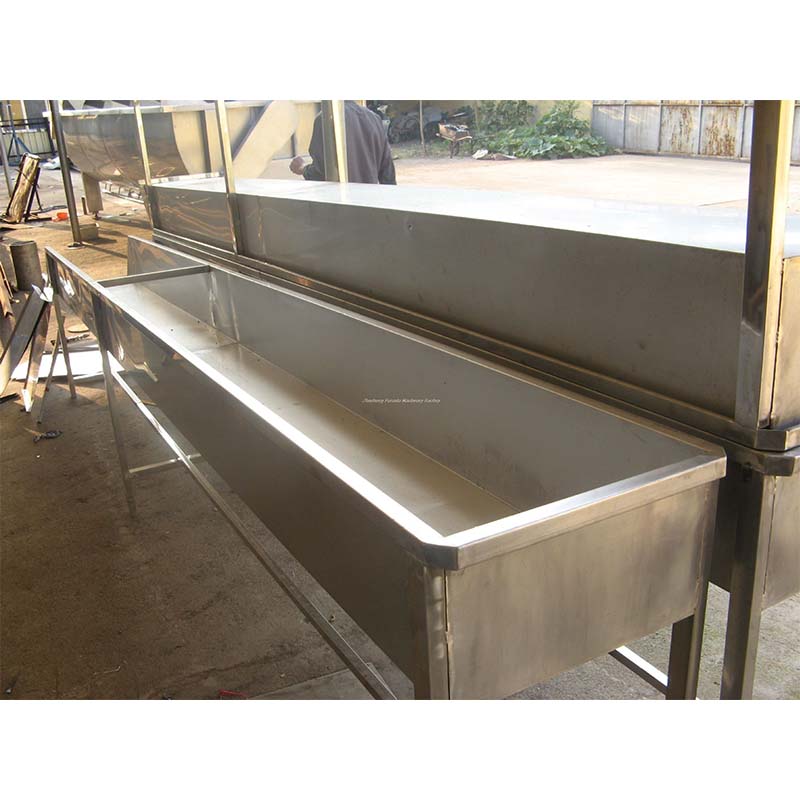Slaughter Equipment Built for Hygiene and Speed—Why Us?
Oct . 20, 2025 14:40 Back to list
Slaughter Equipment Built for Hygiene and Speed—Why Us?
Chicken Slaughter Line Hand Washing Tank: What Plants Are Getting Right (and Wrong)
In poultry plants, slaughter equipment isn’t just blades and conveyors; hygiene hardware sets the tone for the whole shift. The hand washing tank, frankly, is the unsung hero. I’ve walked lines where a well-placed tank cut cross-contamination risk dramatically—and I’ve seen the opposite when it’s an afterthought. This model from Yize Machine sits comfortably at the start or exit of the process, and it shows the category’s quiet evolution: smarter taps, easier cleaning, predictable service life.

Industry trends you can feel on the floor
Plants are shifting to IR-sensor taps to curb water waste (some report 10–15% reductions), and specifying 316 stainless in corrosive washdown zones. Another trend: integrated sanitizer dosing so compliance isn’t “optional.” Many customers say they prefer toe-kick or knee-activated options because they’re simple and durable. And, to be honest, procurement teams now want proof—ATP swab numbers, real cleaning times, and parts availability—before they sign.
Product snapshot: Yize Machine hand washing tank
| Spec | Details (≈ real-world use may vary) |
|---|---|
| Model | Chicken slaughter line hand washing tank |
| Materials | SUS 304 (standard), SUS 316 (optional); TIG-welded, passivated; surface finish Ra ≤ 0.8 μm |
| Dimensions | ≈ 1800 × 650 × 900 mm; adjustable leveling feet |
| Faucets / Flow | 4–8 stations; 4–6 L/min per station; hot/cold mixing |
| Sanitizing | IR sensor or foot/knee control; dosing pump (24V) optional |
| Drainage | Ø50 mm outlet; removable trap and screen |
| CIP/Utilities | Tri-Clamp DN25 port (optional); 1/2" BSP water; 24V control |
| Compliance | HACCP design, ISO 22000 alignment, EN 1672-2, CE |
| Service life | 8–12 years with routine maintenance |
| Origin | Jinwang Western Street, Industrial Zone, Anping County, Hengshui, Hebei, China |

Process flow, methods, and testing
Materials: food-grade stainless (ASTM A240 304/316); silicone gaskets; NSF-grade hoses. Methods: TIG welding, bead-passivation, rounded radii to avoid harborage. Typical flow: (1) Pre-shift wash/sanitize (20–30 sec wash + 20 sec sanitize); (2) Mid-shift rewash between operations (60–90 sec); (3) End-of-shift flush at 60–70°C; weekly CIP through Tri-Clamp port.
Testing: ATP swab targets
Vendor comparison (quick take)
| Vendor | Material | Lead time | Warranty | Customization | Certs |
|---|---|---|---|---|---|
| Yize Machine | 304/316 SS | ≈ 3–5 weeks | 18 months | High (faucets, dosing, size) | CE, ISO system |
| EuroClean Process | 304 SS | ≈ 6–8 weeks | 12 months | Medium | CE, EHEDG guideline |
| US PoultryTech | 304/316 SS | ≈ 4–6 weeks | 24 months | High | UL-listed controls |

Applications, customization, and a quick case
Where it fits: poultry primary processing, halal-certified lines, small abattoirs modernizing legacy layouts, and integrated broiler plants running 6,000–12,000 bph. Custom options include 6–10 faucet arrays, IR sensors vs. knee control, heated water loops, embossed foot plates, and branded signage to reinforce SOPs. If you’re mixing with other slaughter equipment, specify drain alignment early—saves rework.
Case study: a Southeast Asia poultry plant upgraded two stations to IR-sensor tanks. Water use dropped ≈12% month over month; ATP non-conformances fell by 38% within six weeks. Operators said the basin depth “actually keeps splash back off aprons,” which sounds small but matters on a 10-hour shift. Maintenance logged sub-20-minute weekly CIP, which is respectable.

Final notes
If you’re layering this with other slaughter equipment, prioritize flow paths, elbow room for supervisors, and detergent/dosing access. Get the paperwork—material certs, weld maps, and cleaning SOPs—up front. It seems basic, but it’s how you avoid “surprise” audit findings.
Authoritative citations
-
Evisceration Table - Hygienic, Stainless Steel, Easy-Clean
NewsNov.17,2025
-
Chicken Plucker and Scalder | Fast, Stainless, Adjustable
NewsNov.17,2025
-
Silo Solutions: Durable, Automated, Batching-Ready Storage
NewsNov.17,2025
-
Automatic Drinking Line for Poultry | Precise & Durable
NewsNov.17,2025
-
Cutting Machine for Meat & Bone | High-Precision, Safe
NewsNov.17,2025
-
Chicken Feet Peeling Machine | Fast, Hygienic, High-Yield
NewsNov.10,2025






